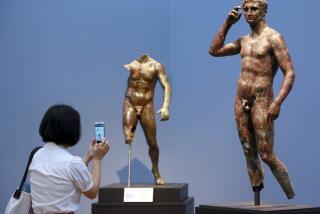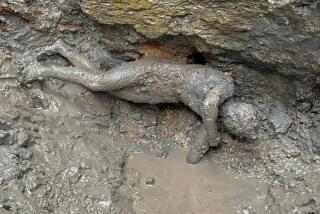Matched set goes to Getty
A pair of ancient marble sculptures, “Venus de’ Medici” and “Dancing Faun,” have been major attractions at the Uffizi Gallery in Florence since 1688, and that’s not likely to change. But in a few months, bronze casts of the life-size Hellenistic figures will become the centerpiece of the neoclassical sculpture galleries at the J. Paul Getty Museum.
The Getty recently purchased the bronzes for an undisclosed sum from London dealer Daniel Katz, after the British Cultural Ministry’s effort to keep the artworks in England failed to raise the officially recommended price of about $10 million.
Made in 1724 by Florentine sculptor Pietro Cipriani, the nudes -- one depicting a demure goddess of love, the other a sprightly male equipped with cymbals and a foot clapper -- were commissioned by George Parker, the 2nd Earl of Macclesfield, for display at his family’s seat, Shirburn Castle in Oxfordshire. They remained in the family until December 2005, when they went on the block at Christie’s London with an estimated value of between $4 million and $8 million. But after no buyer emerged at the auction, Katz purchased them privately and put them on view in his gallery.
Rare set
The sculptures were produced during a period when wealthy English gentlemen often returned from Grand Tours of Europe with bronze copies of Roman statuary that was executed in marble but is thought to have been based on lost Greek bronzes. Small copies of the “Venus de’ Medici” and “Dancing Faun” -- collected by the Medicis and housed in the Uffizi’s tribuna, or treasury -- are relatively common. The Getty’s pair is one of three meticulously crafted full-scale sets made in the early 18th century.
Cipriani’s mentor, Massimilano Soldani Benzi, made the other two sets, said Antonia Bostrom, the Getty’s curator of sculpture and decorative arts. One pair, usually displayed at the Lichtenstein Palace in Vienna but currently on exhibition at Galerie J. Kugal in Paris, is in excellent condition. The other, made for the Earl of Marlborough and, until recently, installed on the grounds of England’s Blenheim Palace, has suffered from exposure to the elements.
The Getty’s bronzes have fared much better.
“What is amazing is that they have been kept inside since they were brought to England,” Bostrom said. “The patina is in exceptional condition, and Cipriani did such fabulous work on the hair, eyes, lips, fingernails, toenails and the strap of the cymbals. He used a punch to get this texture. It’s a wonderful contrast against the smoothness of the skin, and it’s all done by hand.
“These two are well known from reductions,” she said, referring to smaller versions of the figures. “But to have them at this scale, true to the scale of the originals, is really special.” “Venus” is about 5 feet tall, and “Faun” is about 4 feet, 8 inches.
The Grand Tour
Although little is known of Cipriani, who lived from about 1679 to 1745, there is substantial documentation about George Parker, who commissioned the sculptures on behalf of his father, the 1st Earl of Macclesfield, Bostrom said. Parker traveled in Italy in 1720-22 with a tutor, Edward Wright, “doing what British collectors were doing, decorating their grand stately homes with fruits of the Grand Tour,” she said.
The Getty’s new “fruits” will complement Adriaen de Vries’ “Juggling Man,” an earlier version of the “Dancing Faun” in the Getty’s collection, Bostrom said. “We will put them in the West Pavilion as soon as we humanly can. But this prompts us to rethink the installation of the sculpture gallery. In the future, I’d like to think about the Grand Tour as a theme for part of the permanent collection, maybe including works on paper.”
--
More to Read
The biggest entertainment stories
Get our big stories about Hollywood, film, television, music, arts, culture and more right in your inbox as soon as they publish.
You may occasionally receive promotional content from the Los Angeles Times.










